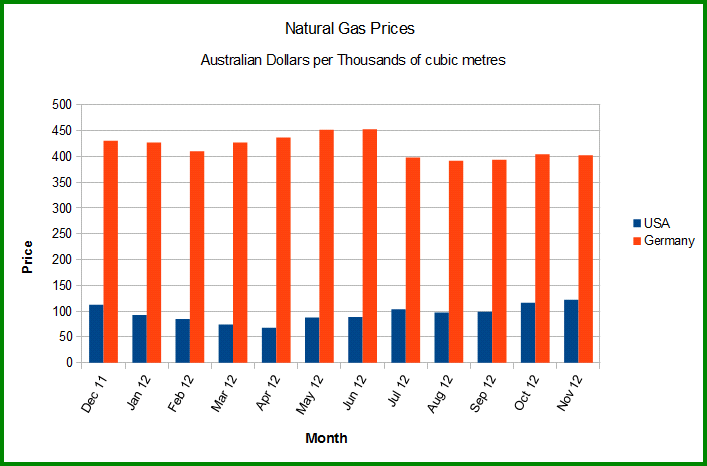There are reasons to suspect that the fossil fuel energy industry has had a hand in thwarting the commercial development of energy storage technology - to its advantage and to the detriment of the renewable energy industry.
As the difference between peak and off-peak electricity tariffs grow ever wider, the payback periods on energy storage systems grow shorter.
One example is recently announced Time of Use tariffs for small business using up to 40,000 kilowatt-hours (kWh) a year in New South Wales. These have a whopping 36 cents per kWh difference between the peak and off-peak price.
- The peak period is 2:00 pm to 8:00 pm Monday-Friday.
- The shoulder periods are 7:00 am to 2:00 pm and 8:00 pm to 10 pm Monday-Friday.
- The off-peak period is 10:00 pm to 7:00 am Monday to Friday:

|
| Small Business Time of Use Electricity Tariffs |
Sources: ORIGIN business price guide for New South Wales customer with Time-of-Use meter and annual electricity consumption falling within the Small Business Energy category for Ausgrid (Code EA225 = Less than 40 Megawatt-hours per year).
ORIGIN energy Rates 2, 4 and 6 for peak period energy use are 44.3 cents per kilowatt-hour excluding GST. (48.73 cents per kilowatt-hour including GST.)
Here is an example of the costs of electricity used from 8:00 am to 8:00 pm, Monday to Friday, 52 weeks per year for a business that uses 10 kWh each hour over this period:
| Interval | Energy Use kWh |
Shoulder kWh |
Shoulder Cost |
Peak kWh |
Peak Cost |
Total Cost |
|---|---|---|---|---|---|---|
| Hourly | 10 | 5 | $1.14 | 5 | $2.44 | $3.58 |
| Daily | 120 | 60 | $13.66 | 60 | $29.24 | $42.90 |
| Weekly | 600 | 300 | $68.31 | 300 | $146.19 | $214.50 |
| Yearly | 31,200 | 15,600 | $3,552.12 | 15,600 | $7,601.88 | $11,154.00 |
During the peak period of 2:00 pm to 8:00 pm each day 60 kilowatt-hours is used. This costs $29.24 per day and $7,601.88 a year. The cost of this much energy at the off-peak tariff is only $0.64 per day and $1,990.56 a year. That is $5,611.32 a year less than the peak period cost.
It is worth keeping a close watch on the availability of 60-70 kWh Zinc-Air batteries that are estimated to cost about $10,000. This amount of energy storage could deliver the saving of about $5,600 a year calculated in the above example.
A word of caution especially for investors and technology developers
Zinc-Air Fuel Cells were heralded as a great idea over ten years ago. Many investors put money into a series of start-ups that supposedly were intended to bring the technology to market.Some of the investors formed the view that their funds were in fact collected for the benefit of company directors and relatives of company directors.
The technology may well be commercially viable and the fate of the start-up companies may have hinged on other factors.
For example, company directors named in a web post by disaffected shareholders are also company officers in businesses involved in coal seam gas production.
Commercially viable energy storage devices, whether they are Zinc-Air Refuelable Batteries developed at the prestigious Lawrence Livermore National Laboratory, or Vanadium Redox Flow Batteries invented and developed at the University of New South Wales, will greatly assist the commercial success of renewable energy technology. This success may come at the expense of fossil fuel energy suppliers.
Company directors with substantial financial interests in the coal seam gas industry may not be highly motivated to bring a competing technology such as zinc-air energy storage successfully to market.
For a history of Zinc-Air Refuelable Batteries see -
1. Zinc Air Refuelable Battery - Review - October 1995
2. Zinc Air Battery Bus Trial - Report - March 2004
3. Power Air Corporation - Corporate Summary - January 2006
4. Power Air Dynamics Limited - Shareholders Newsletter - February 2006
5. Shareholders web post on where their money went - circa April 2006
6. How We Got the Money--Zinc Air Technology: Go Public - June/July 2006
7. Power Air Corporation - Notification of Bankruptcy - February 2012









